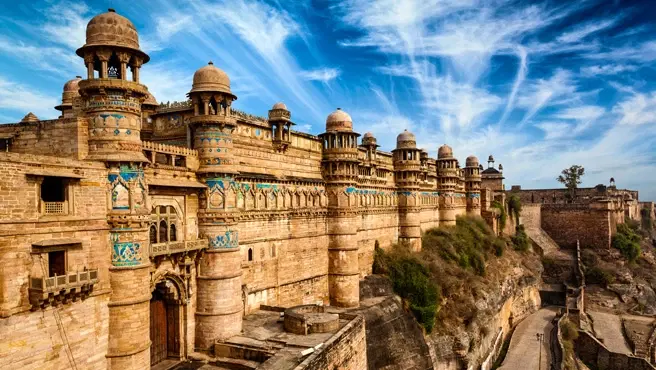
Hotels
•04 min read

Akbar Fort in Allahabad stands as a majestic symbol of history and power. Overlooking the banks of the Yamuna River in Prayagraj, this ancient fort carries the spirit of an era that shaped northern India. Built by Emperor Akbar in 1583, the fort not only served as a stronghold but also as an architectural statement of Mughal grandeur. In this blog post, we answer frequently asked questions about the fort’s history, its unique architecture, and what you can expect when visiting one of Uttar Pradesh’s ancient landmarks. As you read, you will gain a deeper understanding of the fort’s historical importance, its stunning design, and useful tips for exploring this treasure of Allahabad historical places.
Emperor Akbar was known for his ambition and wisdom. He built the fort near the confluence of the Ganges, Yamuna, and the mythical Saraswati rivers, also known as Triveni Sangam. This strategic location was chosen not only for its scenic beauty along the Yamuna river but also to consolidate his empire in northern India. Akbar’s vision of a united and powerful realm is clearly reflected in the fort’s grand design. As a Mughal fort in Prayagraj, it widely influenced the formation of future architectural masterpieces and set benchmarks for later constructions, including other Mughal monuments in India.
The fort has seen many chapters of Indian history unfold within its walls. It witnessed revolts led by Prince Salim, who later took on the title of Emperor Jahangir. The turbulent times during the Mughal dynasty and the eventual transition under British rule have left their unmistakable marks on the structure. The influence of Akbar’s legacy in Allahabad is evident in its repeated mention in history. Today, the fort stands as a silent reminder of the complex cultural and political transformations in India. It continues to be a point of interest among enthusiasts of ancient forts in Uttar Pradesh.
Akbar Fort in Allahabad is a fine example of how Mughal era constructions blend functionality with beauty. The fort displays traditional Mughal design elements such as high walls, decorative balconies, and elaborate carvings. Local materials were used, which allowed the structure to harmonize with its natural surroundings along the Yamuna river. Elements of this design are similar to other famous Mughal monuments in India, yet the fort has its own distinct character. Its design showcases not only the artistic skills of the era but also the tactical ingenuity of its builders.

Visitors will marvel at the fort’s many notable features. One of the standout structures is the ancient Ashoka Pillar, which dates back to 232 BCE. The pillar is inscribed with edicts from Emperor Ashoka’s reign and represents a unique confluence of Mughal and ancient Indian heritage. Another remarkable feature is the Akshayavat tree, a living symbol of history. The fort also has mysterious underground chambers that spark the imagination. The placement of the fort along the Yamuna river adds to its defensive strategy while enhancing its aesthetic appeal.
Did You Know?
Akbar Fort is home to the ancient Ashoka Pillar. This pillar, dating back to 232 BCE, is inscribed with edicts from Emperor Ashoka’s reign. It stands as a rare blend of Mughal influences and ancient Indian heritage.
Though much of the fort remains a relic of the past, it continues to attract history lovers and curious travelers. Parts of Akbar Fort in Allahabad are closed to the public because of its military occupation. However, several areas, such as the section featuring the Ashoka Pillar and Akshayavat tree, are open for tourist attractions in Allahabad. When planning your visit, check local resources for updated timings, ticket prices, and any special guidelines for visitors. This fort on the Yamuna river carries a sense of mystery and charm that is hard to find elsewhere.
Your journey to Akbar Fort should not stop at its gates. Allahabad offers a rich tapestry of historical sites. A visit to Khusro Bagh reveals beautiful gardens and historical monuments that celebrate Mughal fort architecture. The Allahabad Museum houses artifacts that echo deep-rooted traditions. Saraswati Ghat, with its serene waters and cultural significance, provides moments of tranquility. When you explore these sites, you immerse yourself in the heritage of Allahabad historical places and the spirit of microcosms of Mughal era constructions that still inspire today.
Akbar Fort was constructed in 1583 near Triveni Sangam in Prayagraj.

The fort was established by Emperor Akbar to consolidate Mughal power in northern India. It later played a role during revolts and transitioned under British rule.
Some areas remain closed because the fort is partly used by the Indian Army.
Yes, visitors can explore several public areas including views of the Ashoka Pillar and the Akshayavat tree. Please check the latest timings before visiting.
The fort features magnificent Mughal design. Its highlights include intricate carvings, underground chambers, the Ashoka Pillar, and the famed Akshayavat tree.
Akbar Fort in Allahabad is an enduring monument that embodies Akbar’s legacy and the brilliance of Mughal architecture. It stands as a reminder of the grandiose past and profound historical shifts that date back centuries. The fort attracts tourists and history enthusiasts alike, all eager to experience a piece of India’s deep cultural heritage. From its significant location along the Yamuna river to its unique design elements that blend ancient and Mughal influences, the fort casts a spell that beckons every curious traveler. By exploring this Mughal fort in Prayagraj, individuals walk in the footsteps of history, gaining insights into the evolution of art, architecture, and power. The charm of Allahabad historical places comes alive as each stone tells a tale of valiant emperors, groundbreaking construction, and a resilient legacy that continues to inspire even today.